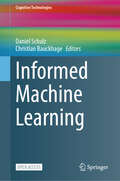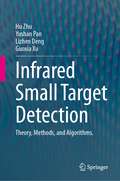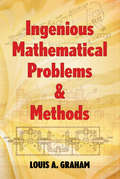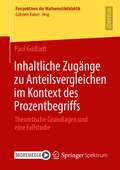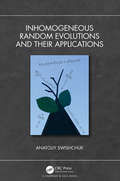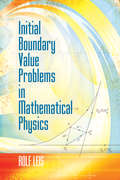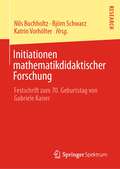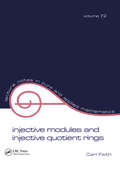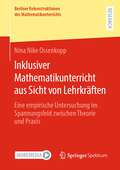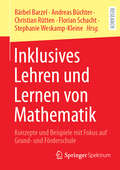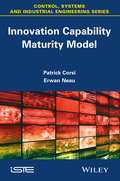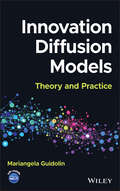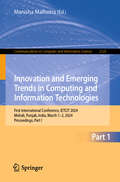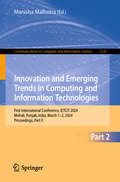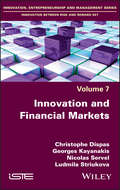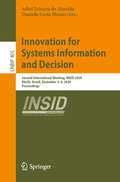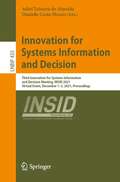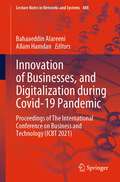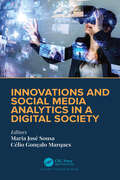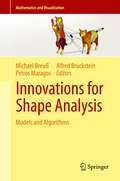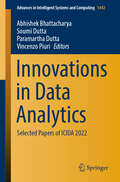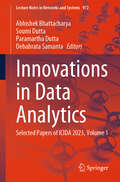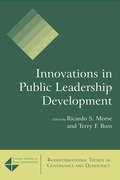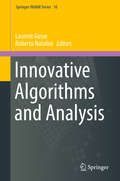- Table View
- List View
Informed Machine Learning (Cognitive Technologies)
by Daniel Schulz Christian BauckhageThis open access book presents the concept of Informed Machine Learning and demonstrates its practical use with a compelling collection of applications of this paradigm in industrial and business use cases. These range from health care over manufacturing and material science to more advanced combinations with deep learning, say, in the form of physical informed neural networks. The book is intended for those interested in modern informed machine learning for a wide range of practical applications where the aspect of small data sets is a challenge. Machine Learning with small amounts of data? After the recent success of Artificial Intelligence based on training with massive amounts of data, this idea may sound exotic. However, it addresses crucial needs of practitioners in industry. While many industrial applications stand to benefit from the use of AI, the amounts of data needed by current learning paradigms are often hard to come by in industrial settings. As an alternative, learning methods and models are called for which integrate other sources of knowledge in order to compensate for the lack of data. This is where the principle of “Informed Machine Learning” comes into play. Informed Machine Learning combines purely data driven learning and knowledge-based techniques to learn from both data and knowledge. This has several advantages. It reduces the need for data, it often results in smaller, less complex and more robust models, and even makes machine learning applicable in settings where data is scarce. The kind of knowledge to be incorporated into learning processes can take many different forms, for example, differential equations, analytical models, simulation results, logical rules, knowledge graphs, or human feedback which makes the approach overall very powerful and widely applicable.
Infrared Small Target Detection: Theory, Methods, and Algorithms.
by Hu Zhu Yushan Pan Lizhen Deng Guoxia XuUncover the secrets of cutting-edge research in “Infrared Small Target Detection,” a crucial resource that delves into the dynamic world of infrared imaging and detection algorithms. This comprehensive book is an indispensable gem for the research community, offering a profound introduction to the theory, methods, and algorithms underlying infrared small object detection. As an invaluable guide, this book explores diverse models and categories of infrared small object detection algorithms, providing meticulous descriptions and comparisons of their strengths and limitations. Perfectly tailored for researchers, practitioners, and students with a passion for infrared imaging and detection, this book equips readers with the necessary knowledge to embark on groundbreaking investigations in this field.Readers can particularly be drawn to the book's methods, results, and topics, encompassing diverse categories of infrared small object detection algorithms and their corresponding advantages and disadvantages. The book also imparts foundational knowledge in mathematical morphology, tensor decomposition, and deep learning, enabling readers to grasp the underlying principles of these advanced algorithms. Experience the key benefits of “Infrared Small Target Detection” as readers gain a profound understanding of theory, methods, and algorithms tailored to infrared small object detection. The comprehensive descriptions and comparisons of various algorithm categories empower readers to select the perfect algorithms for their specific applications. Unlock the potential of this groundbreaking resource with a basic understanding of mathematics, statistics, and image processing. Some familiarity with infrared imaging and detection proves advantageous in fully immersing oneself in the wealth of knowledge presented within these pages.
Ingenious Mathematical Problems and Methods
by Louis A. GrahamFor two decades, an international readership of workers in applied mathematics submitted their favorite puzzles to a mid-twentieth-century column, The Graham Dial. This original collection features 100 of the publication's very best problems, with themes ranging from logic and engineering situations to number theory and geometry. Each problem was specifically selected for its widely differing modes of solution, and most include several methods of solution plus assessments of their efficacy.In checking their solutions against the book's, readers may find that their interest in the puzzles increases. The search for an answer can develop into a challenge to improve upon existing solutions, as in a friendly competition among dozens of keen-witted, problem-solving engineers and mathematical puzzle fans. More than two dozen "mathematical nursery rhymes" appear throughout the book, which concludes with a final section of 25 "quickies" that will test readers' speed.
Inhaltliche Zugänge zu Anteilsvergleichen im Kontext des Prozentbegriffs: Theoretische Grundlagen und eine Fallstudie (Perspektiven der Mathematikdidaktik)
by Paul GudladtPaul Gudladt zeigt durch empirische Untersuchungen, dass Denkwege von Lernenden in der Prozentrechnung mittels ikonischer Darstellungen rekonstruiertert und kategorisiert werden können. Dabei werden bestehende didaktische Annahmen durch Transkriptausschnitte belegt und weiter ausdifferenziert. Eine neue Kategorie des Darstellens von Anteilen wird zusätzlich rekonstruiert und dargelegt. Die verschiedenen Denkmuster werden auf ihre Tragfähigkeit hin untersucht und miteinander verglichen.
Inhomogeneous Random Evolutions and Their Applications
by Anatoliy SwishchukInhomogeneous Random Evolutions and Their Applications explains how to model various dynamical systems in finance and insurance with non-homogeneous in time characteristics. It includes modeling for: financial underlying and derivatives via Levy processes with time-dependent characteristics; limit order books in the algorithmic and HFT with counting price changes processes having time-dependent intensities; risk processes which count number of claims with time-dependent conditional intensities; multi-asset price impact from distressed selling; regime-switching Levy-driven diffusion-based price dynamics. Initial models for those systems are very complicated, which is why the author’s approach helps to simplified their study. The book uses a very general approach for modeling of those systems via abstract inhomogeneous random evolutions in Banach spaces. To simplify their investigation, it applies the first averaging principle (long-run stability property or law of large numbers [LLN]) to get deterministic function on the long run. To eliminate the rate of convergence in the LLN, it uses secondly the functional central limit theorem (FCLT) such that the associated cumulative process, centered around that deterministic function and suitably scaled in time, may be approximated by an orthogonal martingale measure, in general; and by standard Brownian motion, in particular, if the scale parameter increases. Thus, this approach allows the author to easily link, for example, microscopic activities with macroscopic ones in HFT, connecting the parameters driving the HFT with the daily volatilities. This method also helps to easily calculate ruin and ultimate ruin probabilities for the risk process. All results in the book are new and original, and can be easily implemented in practice.
Initial Boundary Value Problems in Mathematical Physics (Dover Books on Mathematics)
by Rolf LeisAn introduction to both classical scattering theory and to the time-dependent theory of linear equations in mathematical physics, this text is suitable for advanced undergraduates and graduate students of physics and applied mathematics. Topics include proof of the existence of wave operators, some special equations of mathematical physics -- including Maxwell equations, the linear equations of elasticity and thermoelasticity, and the plate equation -- exterior boundary value problems, radiation conditions, and limiting absorption principles. The self-contained treatment provides background for a complete understanding of all concepts, and an extensive reference list offers suggestions for further reading. Based on the author's lectures at the University of Bonn in 1983-84, this volume will prove useful to researchers as well as students.
Initiationen mathematikdidaktischer Forschung: Festschrift zum 70. Geburtstag von Gabriele Kaiser
by Katrin Vorhölter Nils Buchholtz Björn SchwarzDiese Festschrift anlässlich Gabriele Kaisers 70. Geburtstags führt Beiträge von mathematikdidaktischen Forscherinnen und Forschern zusammen, denen Gabriele Kaiser in ihrer eigenen wissenschaftlichen Laufbahn die entscheidenden Impulse gegeben hat, und die heute auf die gemeinsame Zeit mit Gabriele zurückblicken. Im Laufe der Jahre prägten dabei unterschiedliche mathematikdidaktische Schwerpunkte das wissenschaftliche Werk von Gabriele Kaiser. Entsprechend vereinigt die Festschrift Beiträge zur Mathematischen Modellierung, zur Lehrerprofessionsforschung und zum Umgang mit Heterogenität.
Injective Modules and Injective Quotient Rings
by Carl FaithFirst published in 1982. These lectures are in two parts. Part I, entitled injective Modules Over Levitzki Rings, studies an injective module E and chain conditions on the set A^(E,R) of right ideals annihilated by subsets of E. Part II is on the subject of (F)PF, or (finitely) pseudo-Frobenius, rings [i.e., all (finitely generated) faithful modules generate the category mod-R of all R-modules]. (The PF rings had been introduced by Azumaya as a generalization of quasi-Frobenius rings, but FPF includes infinite products of Prufer domains, e.g., Z w .)
Inklusiver Mathematikunterricht aus Sicht von Lehrkräften: Eine empirische Untersuchung im Spannungsfeld zwischen Theorie und Praxis (Berliner Rekonstruktionen des Mathematikunterrichts)
by Nina Nike OssenkoppInklusiver Mathematikunterricht – ein Spannungsverhältnis zwischen Theorie und Praxis? Inklusion ist seit dem Inkrafttreten der UN-Behindertenrechtskonvention (UN-BRK) im März 2009 ein Anspruch, dem sich Lehrkräfte an deutschen Grundschulen stellen müssen. Dies bedeutet auch, dass die einzelnen Fachdidaktiken ein Umdenken vollziehen mussten. So wurden auch in der Mathematikdidaktik spezifische Konzepte erarbeitet, die es ermöglichen sollen, dass alle Kinder – mit oder ohne sonderpädagogischen Förderbedarf – am gemeinsamen Mathematikunterricht teilhaben können. In diesem Buch thematisiert Nina Ossenkopp die Frage, inwiefern sich ein inklusiver Mathematikunterricht auf der Basis des aktuellen Entwicklungsstands einer „inklusiven Mathematikdidaktik“ bereits realisieren lässt und welche Spannungen zwischen der Theorie und der Praxis bestehen. Um diese Frage beantworten zu können, wird im ersten Teil der Arbeit rekonstruiert, welche Leitideen, Methoden und Vorstellungen in der Mathematikdidaktik für einen inklusiven Mathematikunterricht existieren. Im zweiten Teil wird der Frage nachgegangen, wie sich ein inklusiver Mathematikunterricht aus Perspektive der Lehrkräfte auch tatsächlich gestalten lässt. Welche Herausforderungen und Chancen sehen sie im inklusiven Mathematikunterricht? Was bedeutet für sie der Versuch, unter den gegebenen Rahmenbedingungen den Mathematikunterricht inklusiv zu gestalten?
Inklusives Lehren und Lernen von Mathematik: Konzepte und Beispiele mit Fokus auf Grund- und Förderschule
by Bärbel Barzel Florian Schacht Andreas Büchter Christian Rütten Stephanie Weskamp-KleineDer Umgang mit einem vielfältigen Heterogenitätsspektrum stellt im Mathematikunterricht verschiedener Schulformen eine zentrale Anforderung dar. Im vorliegenden Sammelband, der anlässlich des 60. Geburtstages von Petra Scherer entstanden ist, wird diese Thematik fachdidaktisch aus unterschiedlichen Perspektiven bearbeitet, indem Konzepte und Beispiele aus verschiedenen Projekten mit Fokus auf Grund- und Förderschule zur Realisierung von inklusivem Lehren und Lernen betrachtet werden. Einige Beiträge beleuchten die Entwicklung und Erforschung von Lernumgebungen, in denen die individuellen Voraussetzungen und Lernwege der Lernenden Berücksichtigung finden. Dabei können auch digitale Medien das gemeinsame Lernen unterstützen. Ein inklusionssensibler Mathematikunterricht setzt ein adäquates Diagnostizieren und Fördern durch die Lehrkräfte voraus, welche einer entsprechenden Professionalisierung bedürfen. Diese Aspekte werden in weiteren Beiträgen ebenso in der Verknüpfung von wissenschaftlicher und unterrichtspraktischer Perspektive auf die Entwicklung und Erforschung von Mathematikunterricht entfaltet.
Innovation Capability Maturity Model
by Patrick Corsi Erwan NeauWhilst innovation remains of course an approach, a process, and is still often even reduced to a set of results, it essentially reflects a way of thinking evolution. Time is up for varying the thinking methods according to capacities and learned and available competencies with a view to change. . . the thinking level. No domain and no sector is immune to this transformation in todays' world Having clarified our ideas through this book, we remain ever more convinced that the leveled maturity approach will lead to real advances in innovation over the 2020 years. Hence the competitive capacities of organizations must evolve. As we strive in our quest for new inspiration sources in business, let us reckon that all is bound to evolving. . . including the way to evolve. In that resides the very capacity to innovate.
Innovation Diffusion Models: Theory and Practice
by Mariangela GuidolinInnovation Diffusion Models Understand innovation diffusion models and their role in business success Innovation diffusion models are statistical models that predict the medium- and long-term sales performance of new products on a market. They account for numerous factors that contribute to the life cycle of a new product and are subject to continuous reassessment as markets transform and the business world becomes more complex. In a modern market environment where product life cycles are becoming ever shorter, the latest innovation diffusion models are essential for businesses looking to perfect their decision-making processes. Innovation Diffusion Models: Theory and Practice provides a comprehensive and up-to-date guide to these models and their potential to impact product development. It focuses on the latest product diffusion models, which combine time series analysis with nonlinear regression techniques to create increasingly refined predictions. Its combination of mathematical theory and business practice makes it an indispensable tool across many sectors of industry and commerce. Innovation Diffusion Models readers will also find: Real-world examples demonstrating the kinds of data sets generated by new product growth models and their potential applications Discussion of the factors underlying the decision to select a given growth model for a particular product Clear, detailed explanation of each model’s explanatory ability Innovation Diffusion Models is an essential volume for practitioners in any field of industry or commerce, as well as for graduate students and researchers in business and finance.
Innovation and Emerging Trends in Computing and Information Technologies: First International Conference, IETCIT 2024, Mohali, Punjab, India, March 1–2, 2024, Proceedings, Part I (Communications in Computer and Information Science #2125)
by Manisha MalhotraThis book constitutes the proceedings of the First International Conference on Innovation and Emerging Trends in Computing and Information Technologies, IETCIT 2024, held in Mohali, India, in March 1–2, 2024. The 44 full papers presented in these two volumes were carefully reviewed and selected from 417 submissions. The papers are organized in the following topical sections: Part I: machine learning and deep learning; pattern and speech recognition; internet of things (IoT). Part II: data science and data analytics; communication, network and security.
Innovation and Emerging Trends in Computing and Information Technologies: First International Conference, IETCIT 2024, Mohali, Punjab, India, March 1–2, 2024, Proceedings, Part II (Communications in Computer and Information Science #2126)
by Manisha MalhotraThis book constitutes the proceedings of the First International Conference on Innovation and Emerging Trends in Computing and Information Technologies, IETCIT 2024, held in Mohali, India, in March 1–2, 2024. The 44 full papers presented in these two volumes were carefully reviewed and selected from 417 submissions. The papers are organized in the following topical sections: Part I: machine learning and deep learning; pattern and speech recognition; internet of things (IoT). Part II: data science and data analytics; communication, network and security.
Innovation and Financial Markets
by Christophe Dispas Georges Kayanakis Nicolas Servel Ludmila StriukovaCombining insights from academic research and practical examples, this book aims to better understand the link between financial markets and innovation management. First, we are back to the very definition of innovation and what it means for financial and non-financial companies. Then, we analyze if efficient innovation management by companies is recognized and valued by financial markets. Finally, we focus on innovation within the financial sector: does it really create value outside the financial sector itself. Are Financial innovations value … or risk creators?
Innovation for Systems Information and Decision: Second International Meeting, INSID 2020, Recife, Brazil, December 2–4, 2020, Proceedings (Lecture Notes in Business Information Processing #405)
by Adiel Teixeira de Almeida Danielle Costa MoraisThis book constitutes the refereed proceedings of the Second International Meeting on Innovation for Systems Information and Decision meeting, INSID 2020, held in Recife, Brazil, in December 2020. Due to the COVID-19 pandemic the conference was held virtually. The 8 papers presented in this volume were carefully reviewed and selected from a total of 84 submissions to the main conference. The selected papers reflect methodological improvements and advances in Multicriteria Decision-Making/Multicriteria Decision-Aid (MCDM/MCDA) oriented toward real-world applications and contribute to the understanding of relevant developments of current research on and future trends of Innovation for Systems Information and Decision.
Innovation for Systems Information and Decision: Third Innovation for Systems Information and Decision Meeting, INSID 2021, Virtual Event, December 1–3, 2021, Proceedings (Lecture Notes in Business Information Processing #435)
by Adiel Teixeira de Almeida Danielle Costa MoraisThis book constitutes the refereed proceedings of the Third International Meeting on Innovation for Systems Information and Decision, INSID 2021, which was held during December 1-3, 2021. The conference was initially planned to take place in Recife, Brazil, but changed to a virtual meeting due to the COVID-19 pandemic. The 9 full papers presented in this volume were carefully reviewed and selected from a total of 76 submissions. They reflect methodological improvements and advances in multi-criteria decision-making/multi-criteria decision-aid (MCDM/MCDA) oriented toward real-world applications, which contribute to the understanding of relevant developments of current research on and future trends of innovation for systems information and decision.
Innovation of Businesses, and Digitalization during Covid-19 Pandemic: Proceedings of The International Conference on Business and Technology (ICBT 2021) (Lecture Notes in Networks and Systems #488)
by Allam Hamdan Bahaaeddin AlareeniThis book constitutes the refereed proceedings of the International Conference on Business and Technology (ICBT2021) organized by EuroMid Academy of Business & Technology (EMABT), held in Istanbul, between 06–07 November 2021. In response to the call for papers for ICBT2021, 485 papers were submitted for presentation and inclusion in the proceedings of the conference. After a careful blind refereeing process, 292 papers were selected for inclusion in the conference proceedings from forty countries. Each of these chapters was evaluated through an editorial board, and each chapter was passed through a double-blind peer-review process.The book highlights a range of topics in the fields of technology, entrepreneurship, business administration, accounting, and economics that can contribute to business development in countries, such as learning machines, artificial intelligence, big data, deep learning, game-based learning, management information system, accounting information system, knowledge management, entrepreneurship, and social enterprise, corporate social responsibility and sustainability, business policy and strategic management, international management and organizations, organizational behavior and HRM, operations management and logistics research, controversial issues in management and organizations, turnaround, corporate entrepreneurship, innovation, legal issues, business ethics, and firm gerial accounting and firm financial affairs, non-traditional research, and creative methodologies.These proceedings are reflecting quality research contributing theoretical and practical implications, for those who are wise to apply the technology within any business sector. It is our hope that the contribution of this book proceedings will be of the academic level which even decision-makers in the various economic and executive-level will get to appreciate.
Innovations and Social Media Analytics in a Digital Society
by Maria José Sousa and Célio Gonçalo MarquesRecent advances in digitization are transforming healthcare, education, tourism, information technology, and some other sectors. Social media analytics are tools that can be used to measure innovation and the relation of the companies with the citizens. This book comprises state-ofthe-art social media analytics, and advanced innovation policies in the digitization of society. The number of applications that can be used to create and analyze social media analytics generates large amounts of data called big data, including measures of the use of the technologies to develop or to use new services to improve the quality of life of the citizens. Digitization has applications in fields from remote monitoring to smart sensors and other devices. Integration generates data that need to be analyzed and visualized in an easy and clear way, that will be some of the proposals of the researchers present in this book. This volume offers valuable insights to researchers on how to design innovative digital analytics systems and how to improve information delivery remotely.
Innovations for Shape Analysis
by Alfred Bruckstein Michael Breuß Petros MaragosThe concept of 'shape' is at the heart of image processing and computer vision, yet researchers still have some way to go to replicate the human brain's ability to extrapolate meaning from the most basic of outlines. This volume reflects the advances of the last decade, which have also opened up tough new challenges in image processing. Today's applications require flexible models as well as efficient, mathematically justified algorithms that allow data processing within an acceptable timeframe. Examining important topics in continuous-scale and discrete modeling, as well as in modern algorithms, the book is the product of a key seminar focused on innovations in the field. It is a thorough introduction to the latest technology, especially given the tutorial style of a number of chapters. It also succeeds in identifying promising avenues for future research. The topics covered include mathematical morphology, skeletonization, statistical shape modeling, continuous-scale shape models such as partial differential equations and the theory of discrete shape descriptors. Some authors highlight new areas of enquiry such as partite skeletons, multi-component shapes, deformable shape models, and the use of distance fields. Combining the latest theoretical analysis with cutting-edge applications, this book will attract both academics and engineers.
Innovations in Data Analytics: Selected Papers of ICIDA 2022 (Advances in Intelligent Systems and Computing #1442)
by Vincenzo Piuri Paramartha Dutta Abhishek Bhattacharya Soumi DuttaThis book features research papers presented at the 1st International Conference on Innovations in Data Analytics (ICIDA 2022), held at Eminent College of Management and Technology (ECMT), West Bengal, India, during November 29–30, 2022. The book presents original research work in the areas of computational intelligence, advance computing, network security and telecommunication, data science and data analytics, and pattern recognition. The book is beneficial for readers from both academia and industry.
Innovations in Data Analytics: Selected Papers of ICIDA 2023, Volume 1 (Lecture Notes in Networks and Systems #972)
by Paramartha Dutta Abhishek Bhattacharya Soumi Dutta Debabrata SamantaThis book features research papers presented at the 2nd International Conference on Innovations in Data Analytics (ICIDA 2023), held at Eminent College of Management and Technology (ECMT), West Bengal, India during 29 – 30 November 2023. The book presents original research work in the areas of computational intelligence, advance computing, network security and telecommunication, data science and data analytics, and pattern recognition. The book is beneficial for readers from both academia and industry.
Innovations in Data Analytics: Selected Papers of ICIDA 2023, Volume 2 (Lecture Notes in Networks and Systems #1005)
by Paramartha Dutta Abhishek Bhattacharya Soumi Dutta Debabrata SamantaThis book features research papers presented at the 2nd International Conference on Innovations in Data Analytics (ICIDA 2023), held at Eminent College of Management and Technology (ECMT), West Bengal, India during 29 – 30 November 2023. The book presents original research work in the areas of computational intelligence, advance computing, network security and telecommunication, data science and data analytics, and pattern recognition. The book is beneficial for readers from both academia and industry.
Innovations in Public Leadership Development (Transformational Trends In Governance And Democracy Ser.)
by Terry F. Buss Ricardo S. MorseThis is the best single-source guide to leadership development in the public sector. It offers a wealth of advice for teachers, students, trainers, human resource officers, and established leaders. The all-original chapters include discussions of leadership frameworks, competencies for public leaders for the "new governance," and strategies for senior leaders in government.The book's wide-ranging coverage includes in-depth discussions of specific approaches to learning methods such as action learning and social artistry, as well as presentations of leader development models such as transformational stewardship and global leadership. The contributors present experiences from real-world leadership development programs, and the book situates leader development within the current trends of networks, collaboration, and boundary-crossing work in the public sector.
Innovative Algorithms and Analysis
by Laurent Gosse Roberto NataliniThis volume gathers contributions reflecting topics presented during an INDAM workshop held in Rome in May 2016. The event brought together many prominent researchers in both Mathematical Analysis and Numerical Computing, the goal being to promote interdisciplinary collaborations. Accordingly, the following thematic areas were developed: 1. Lagrangian discretizations and wavefront tracking for synchronization models; 2. Astrophysics computations and post-Newtonian approximations; 3. Hyperbolic balance laws and corrugated isometric embeddings; 4. "Caseology" techniques for kinetic equations; 5. Tentative computations of compressible non-standard solutions; 6. Entropy dissipation, convergence rates and inverse design issues. Most of the articles are presented in a self-contained manner; some highlight new achievements, while others offer snapshots of the "state of the art" in certain fields. The book offers a unique resource, both for young researchers looking to quickly enter a given area of application, and for more experienced ones seeking comprehensive overviews and extensive bibliographic references.
